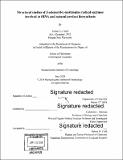| dc.contributor.advisor | Catherine L. Drennan. | en_US |
| dc.contributor.author | Grell, Tsehai A.J. (Tsehai Ariane Julien) | en_US |
| dc.contributor.other | Massachusetts Institute of Technology. Department of Chemistry. | en_US |
| dc.date.accessioned | 2018-09-28T20:59:22Z | |
| dc.date.available | 2018-09-28T20:59:22Z | |
| dc.date.copyright | 2018 | en_US |
| dc.date.issued | 2018 | en_US |
| dc.identifier.uri | http://hdl.handle.net/1721.1/118265 | |
| dc.description | Thesis: Ph. D. in Biological Chemistry, Massachusetts Institute of Technology, Department of Chemistry, 2018. | en_US |
| dc.description | Cataloged from PDF version of thesis. Vita. | en_US |
| dc.description | Includes bibliographical references. | en_US |
| dc.description.abstract | Members of the S-adenosyl-L-methionine (AdoMet) radical enzyme superfamily catalyze a myriad of diverse and challenging biotransformations using a [4Fe-4S] cluster and a molecule of AdoMet to initiate radical. In this thesis, we used a combination of crystallographic and biochemical methods to identify the use of covalent catalysis and polar reactions in two AdoMet radical enzymes that catalyze the key steps in the biosynthesis of the tRNA modified bases wybutosine and queuosine. TYWI catalyzes the formation of the characteristic imidazopurine ring of wybutosine through a disputed mechanism. Here, we have garnered support for one of the proposed mechanisms, through the identification and characterization of a Schiff base between a catalytically essential lysine residue and the substrate pyruvate. The ability of TYWI to form and possibly use a Schiff base presents the first instance of a covalent catalysis in the mechanism of an AdoMet radical enzyme. In an attempt to obtain a snapshot of the active site of the queuosine biosynthetic enzyme, QueE, with AdoMet and a substrate analog, 6-carboxypterin (6-CP), we uncovered a covalent adduct between AdoMet and 6-CP. Further investigation of the mechanism by which this adduct was formed revealed a polar mechanism instead of a radical one. This result highlights the ability for AdoMet radical enzymes to use the same active site for two different reactions, polar and/or radical reactions. The unifying characteristics of this superfamily include the canonical CX₃CX[phi]C cluster-binding motif and a partial ([beta]/[alpha]X) 6 triose isomerase phosphate (TIM) barrel. Work in this thesis presents the structural characterization of a third QueE ortholog from Escherichia coli. Together, these three QueE orthologs revealed different variations in the core barrel architecture, which may influence binding of the biological reductant Flavodoxin. This variance in the core AdoMet radical fold emphasizes the structural diversity of this superfamily. On the other hand, we see conservation of an overall three-domain architecture for the maturation of ribosomally synthesized and post-translationally modified natural products, underlining the importance of this architecture for catalysis. | en_US |
| dc.description.statementofresponsibility | by Tsehai A.J. Grell. | en_US |
| dc.format.extent | 198 pages | en_US |
| dc.language.iso | eng | en_US |
| dc.publisher | Massachusetts Institute of Technology | en_US |
| dc.rights | MIT theses are protected by copyright. They may be viewed, downloaded, or printed from this source but further reproduction or distribution in any format is prohibited without written permission. | en_US |
| dc.rights.uri | http://dspace.mit.edu/handle/1721.1/7582 | en_US |
| dc.subject | Chemistry. | en_US |
| dc.title | Structural studies of S-adenosyl-L-methionine radical enzymes involved in tRNA and natural product biosynthesis | en_US |
| dc.type | Thesis | en_US |
| dc.description.degree | Ph. D. in Biological Chemistry | en_US |
| dc.contributor.department | Massachusetts Institute of Technology. Department of Chemistry | |
| dc.identifier.oclc | 1054178959 | en_US |
